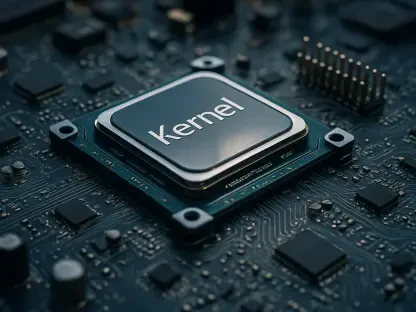Setting the Stage for Power Innovation
Imagine a world where the digital backbone of society—data centers powering everything from cloud computing to artificial intelligence (AI)—consumes more energy than entire countries, and with global data center energy usage already accounting for nearly 2% of total electricity demand, the strain on power systems is undeniable. As AI workloads and high-density computing push rack power requirements to unprecedented levels, sometimes reaching 1 MW per rack, this escalating demand poses a critical challenge: how can power distribution systems evolve to meet efficiency and sustainability goals without compromising reliability? This review dives into the heart of this issue by examining the competing paradigms of alternating current (AC) and direct current (DC) power systems in data centers, shedding light on their capabilities and limitations.
The significance of this topic extends beyond technical specifications. As hyperscale facilities and AI-driven applications proliferate, the choice of power infrastructure directly impacts operational costs, carbon footprints, and the ability to scale with emerging technologies. By exploring the features, performance metrics, and real-world applications of AC and DC systems, this analysis aims to provide clarity on which approach—or combination thereof—holds the key to powering the digital economy sustainably.
Core Features and Performance Analysis
AC Power Systems: The Established Standard
AC power has long been the cornerstone of data center infrastructure, rooted in its compatibility with utility grids and proven reliability over long-distance transmission. This system relies on a network of components like uninterruptible power supplies (UPS), transformers, and power distribution units (PDUs) to deliver electricity to servers and networking equipment. Its widespread adoption is underpinned by a mature ecosystem of standardized equipment and protocols, making it a safe and familiar choice for most operators managing traditional workloads.
However, the performance of AC systems reveals notable drawbacks as data center demands intensify. The multiple conversions between AC and DC required to power IT equipment result in energy losses, often ranging from 5-10%, which become more pronounced with high-density setups. Additionally, the infrastructure’s bulkiness—due to the need for extensive conversion hardware—can limit space efficiency, a critical factor in facilities where every square foot counts.
The reliability of AC systems, while a strength, comes at the cost of adaptability. As AI and graphics processing unit (GPU) workloads drive up power needs, the inefficiencies in conversion and cooling requirements pose challenges to achieving sustainability targets. This raises questions about whether AC can keep pace with the evolving landscape of computational intensity.
DC Power Systems: Efficiency in Focus
In contrast, DC power systems are gaining attention for their potential to address the inefficiencies inherent in AC setups. By eliminating the need for repeated conversions—since most IT equipment inherently operates on DC—these systems can reduce energy losses significantly, with some studies suggesting savings of 7-20% in operational expenditure. The streamlined architecture also translates to smaller footprints for power equipment, freeing up valuable rack space in tightly packed facilities.
Performance-wise, DC systems excel in integration with renewable energy sources like solar photovoltaic (PV) systems and battery storage, which naturally produce or store DC power. This alignment minimizes conversion stages, enhancing overall energy efficiency and supporting green initiatives. Pilot projects, such as those involving high-voltage DC (HVDC) at 400V to 1,500V, demonstrate promising results in handling extreme rack densities while lowering cooling demands.
Yet, the adoption of DC power is not without hurdles. The lack of universal standards and the scarcity of off-the-shelf equipment compatible with high-voltage DC inputs often necessitate custom solutions, driving up complexity. Safety concerns, particularly around arc suppression and fault isolation at higher voltages, further complicate implementation, requiring specialized training and protocols.
Innovations Shaping Power Distribution
Recent advancements in power distribution technologies highlight a shift toward hybrid models that combine the strengths of AC and DC systems. The development of HVDC architectures is a notable trend, offering a pathway to support the massive power needs of AI-centric data centers while maintaining efficiency. Collaborations between industry leaders, such as partnerships to design HVDC infrastructure for GPU workloads, signal a concerted effort to push these innovations into mainstream use.
Another emerging direction is the adoption of hybrid AC/DC setups, where AC handles facility-level transmission and DC powers high-density zones at the rack level. This approach mitigates the risks of a full transition while allowing operators to test DC’s benefits in targeted applications. Initiatives like the Open Compute Project are also driving standardization, ensuring interoperability and scalability as rack densities continue to climb.
The focus on sustainability is evident in designs that integrate DC microgrids with renewable sources, reducing reliance on fossil fuel-based grids. Such innovations not only cut operational costs but also align data centers with global carbon reduction goals. As these technologies mature, their influence on power system design is expected to grow over the next few years, shaping infrastructure for unprecedented computational loads.
Real-World Impact and Deployment
Examining practical applications reveals how AC and DC systems perform under real operational conditions. Hyperscale data centers, which often rely on AC due to existing infrastructure, showcase the system’s ability to manage large-scale power distribution with minimal disruption. These facilities benefit from the robustness of AC’s established supply chain, ensuring uptime even under heavy loads.
Conversely, DC implementations are making inroads in AI-focused environments where efficiency is paramount. A standout example is a collaborative project involving industry giants that successfully deployed a DC-powered facility to support 1 MW racks, achieving a 3% increase in space utilization compared to AC counterparts. Such cases underscore DC’s potential to handle cutting-edge workloads with reduced energy waste.
Green data centers provide another compelling use case, where DC systems are paired with sustainable energy solutions. By directly connecting solar arrays and battery storage to DC distribution networks, these facilities minimize conversion losses and enhance their environmental credentials. These deployments illustrate how power system choices can align with broader goals of ecological responsibility while meeting technical demands.
Challenges in Adoption and Scalability
Despite the promise of DC systems, significant barriers remain in transitioning from the AC-dominated landscape. Technical challenges, such as redesigning critical components like breakers and PDUs for DC compatibility, demand substantial innovation and investment. The absence of standardized protocols further complicates integration, as operators grapple with ensuring equipment interoperability across diverse setups.
Financial considerations also weigh heavily on adoption decisions. The upfront capital expenditure for DC infrastructure is notably higher than maintaining or upgrading AC systems, particularly in retrofitting existing facilities. While long-term savings in operational costs can offset this, the initial hurdle deters many from committing to a full overhaul, especially in budget-constrained environments.
Logistical issues add another layer of complexity, particularly in managing safety risks associated with high-voltage DC. Unlike AC, where fault behaviors are well-understood, DC systems require new approaches to arc management and personnel training. Addressing these challenges through phased migrations and hybrid architectures offers a pragmatic way forward, though it demands careful planning to balance risk and reward.
Reflecting on the Path Traveled
Looking back, the exploration of AC and DC power systems in data centers revealed a nuanced battle between tradition and innovation. AC stood as a reliable foundation, adept at handling broad infrastructure needs but strained by inefficiencies under modern workloads. DC, with its promise of reduced losses and renewable integration, emerged as a transformative contender, though tempered by technical and financial obstacles. The hybrid models tested in recent implementations proved to be a viable compromise, blending stability with forward-thinking efficiency.
Moving ahead, the industry should prioritize standardization efforts to ease DC adoption, ensuring that equipment and safety protocols evolve in tandem with technological advancements. Investment in pilot projects and partnerships can further bridge the gap between concept and deployment, providing actionable data on scalability. Additionally, policymakers and operators must collaborate on incentives for sustainable power solutions, encouraging the shift toward greener infrastructures. As data centers continue to underpin the digital age, these steps will be crucial in crafting power systems that not only meet today’s demands but also anticipate tomorrow’s challenges.









